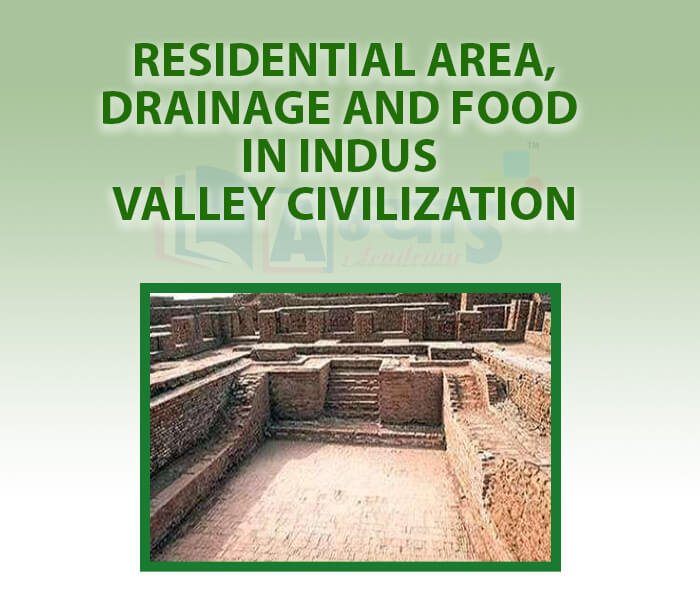Residential Area, Drainage and Food in Indus Valley Civilization









Residential Area, Drainage and Food in Indus Valley Civilization
Residential Area, Drainage and Food in Indus Valley Civilization In the town area,away from the citadel ,platforms were built for houses. These platforms enabled houses in the city to be built above the flood level. Most of the houses were plain and uniform in plan; the rooms of each house were arranged around a courtyard. Each house had a single entrance and one of every three houses had a well too. Many houses had a well too. Many houses had a separate bathing area as well. Some of the houses were double storied.
Drainage: As he houses were built, a careful drainage system was laid out. The drain in houses invariably led to a cess- pool or manhole. The drains along the main roads were covered and were inspected and cleaned regularly. The drainage system of the Indus cities stands out as remarkable among the cities of the world at that time.
What did the people eat? A number of crops were cultivated – cereals like wheat and barley, pulses, oilseeds like mustard and sesame, and millets like bajra, ragi and jawar. Fish, meat, milk, date and fruit were also a part of the diet.
In search of raw materials: Raw materials are substances that are either found naturally (such as wood, or ores of metals) or produced by farmers or herders. These are then processed to produce finished goods. For example, cotton, produced by farmers, is a raw material that may be processed to make cloth. While some of the raw materials that the Harappans used were available locally, many items such as copper, tin, gold, silver and precious stones had to be brought from distant places. Gold could have come all the way from present- day Karnataka, and precious stones from present –day Gujarat, Ian and Afghanistan.
What did they wear: Archaeologists have found evidence of cotton and woven cloth. Spindles (used to spin cotton thread) made of clay have been found in many sites. Men wore flowing lengths of cloth, while the women wore skirts. Both the men and the women seem to have draped a shawl over their shoulders. Both men and women wore ornaments made of gold, silver and beads of semi- precious stones like jade, lapis.
Food for people in the cities: While many people lived in the cities, others living in the countryside grew crops and reared animals. These farmers and herders supplied food to crafts persons, scribes and rulers in the cities. The Harappans reared cattle, sheep, goat and buffalo. Water and pastures were available around settlements. However, in the dry summer months large herds of animals were probably taken to greater distances in search of grass and water.
Did they know how to write? The people of the Indus civilization had developed a form of writing. This was one of the world’s earliest known scripts. Writing was in the form of brief inscriptions found mainly on seals of different materials like, clay, baked clay and steatite. Archaeologists reveal that the writing is usually from right to left.
A place ships were loaded and unloaded and to repaired | |||
| Right Option : D | |||
| View Explanation | |||
Which of the following truly describes the housing, drainage and street conditions of the Harappan civilization ?
| |||
| Right Option : B | |||
| View Explanation | |||
Which of the following was not true about the Indus Valley civilisation ?
| |||
| Right Option : D | |||
| View Explanation | |||
Students / Parents Reviews [10]
Being a parent, I saw my daughter improvement in her studies by seeing a good result in all day to day compititive exam TMO, NSO, IEO etc and as well as studies. I have got a fruitful result from my daughter.

Prisha Gupta
8thAbhyas Methodology is very good. It is based on according to student and each child manages accordingly to its properly. Methodology has improved the abilities of students to shine them in future.

Manish Kumar
10thI have spent a wonderful time in Abhyas academy. It has made my reasoning more apt, English more stronger and Maths an interesting subject for me. It has given me a habbit of self studying

Yatharthi Sharma
10thMy experience with Abhyas academy is very good. I did not think that my every subject coming here will be so strong. The main thing is that the online tests had made me learn here more things.

Hiya Gupta
8thOne of the best institutes to develope a child interest in studies.Provides SST and English knowledge also unlike other institutes. Teachers are co operative and friendly online tests andPPT develope practical knowledge also.

Aman Kumar Shrivastava
10thIt has a great methodology. Students here can get analysis to their test quickly.We can learn easily through PPTs and the testing methods are good. We know that where we have to practice

Barkha Arora
10thAbhyas is a complete education Institute. Here extreme care is taken by teacher with the help of regular exam. Extra classes also conducted by the institute, if the student is weak.

Om Umang
10thIt was a good experience with Abhyas Academy. I even faced problems in starting but slowly and steadily overcomed. Especially reasoning classes helped me a lot.

Cheshta
10thMy experience was very good with Abhyas academy. I am studying here from 6th class and I am satisfied by its results in my life. I improved a lot here ahead of school syllabus.

Ayan Ghosh
8thMy experience with Abhyas is very good. I have learnt many things here like vedic maths and reasoning also. Teachers here first take our doubts and then there are assignments to verify our weak points.
